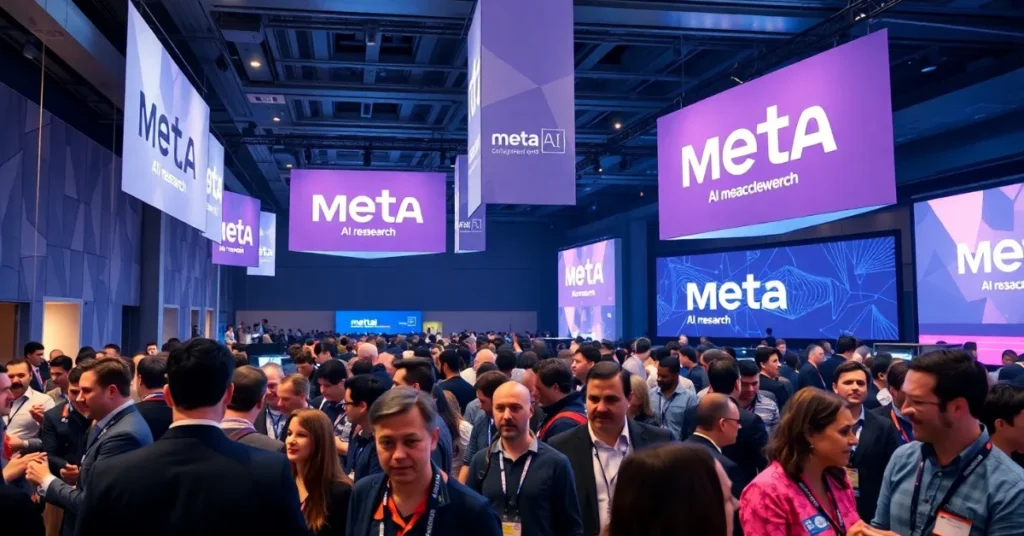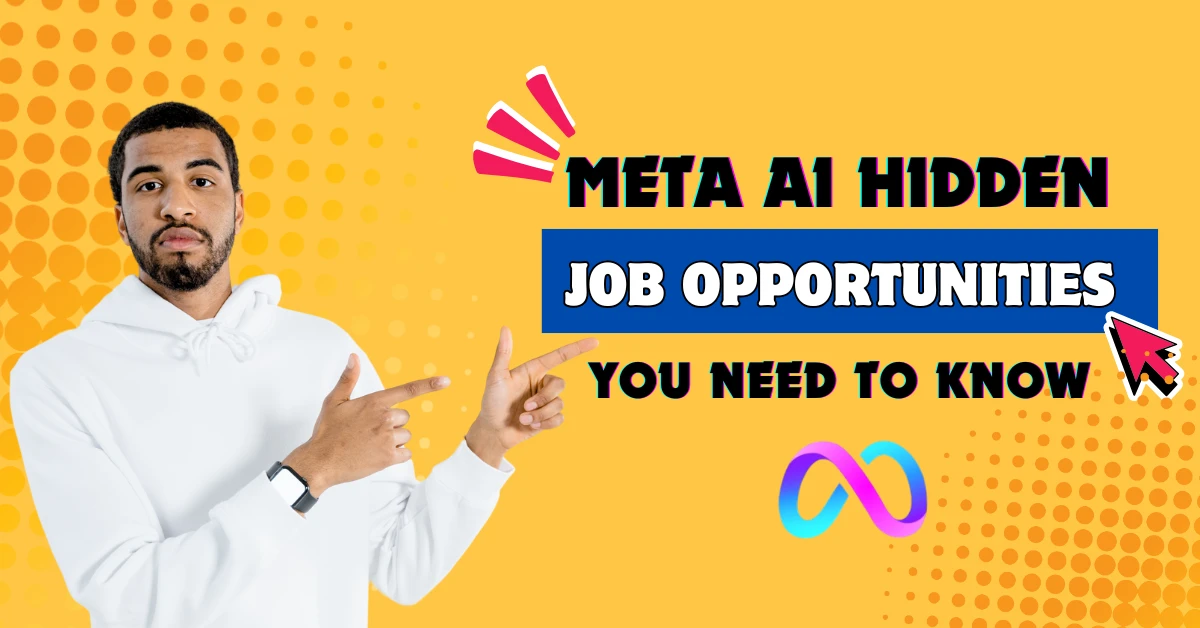Table of Contents
Meta AI Hidden Job Opportunities You Need to Know: Meta’s AI division is hiring aggressively, but the best Meta AI job opportunities aren’t always posted on the main careers page. You might be missing out on hidden positions that could launch your career in artificial intelligence.
This guide is for tech professionals, recent graduates, and career changers who want to break into Meta AI careers or advance within the company. You’ll discover insider strategies that most job seekers never learn about.
We’ll explore how to tap into Meta’s internal job board and referral systems that employees use to find unadvertised positions. You’ll also learn about the high-demand Meta AI skills that recruiters are actively seeking right now. Finally, we’ll cover Meta’s alternative hiring channels and specialized programs that bypass traditional application processes, giving you multiple pathways into Facebook AI jobs that others don’t know exist.

Discover Lesser-Known Career Paths Within Meta’s AI Division
Research Scientist Positions in Emerging AI Fields
You’ll find some of the most exciting Meta AI careers hiding in plain sight within specialized research divisions. Meta’s AI Research (FAIR) lab constantly seeks researchers working on cutting-edge projects like multimodal AI systems, neural architecture search, and federated learning. These positions often fly under the radar because they require highly specific expertise in areas like computational linguistics, computer vision, or reinforcement learning.
Your background in quantum machine learning, neuromorphic computing, or AI for scientific discovery could land you a research scientist role that doesn’t appear on traditional job boards. Meta actively recruits for positions in AI safety research, where you’d work on alignment problems and robustness testing. The company also needs researchers specializing in AI for social good, focusing on applications like disaster response, accessibility technology, and climate change modeling.
Check Meta’s research publications and identify authors whose work aligns with your interests. Many Meta AI job opportunities emerge from direct outreach to research teams rather than formal applications.
AI Ethics and Safety Specialist Roles
Your expertise in responsible AI development puts you in high demand at Meta, where AI ethics and safety roles are rapidly expanding beyond traditional compliance positions. These Meta artificial intelligence hiring opportunities include positions like AI fairness engineers, algorithmic bias researchers, and responsible AI product specialists.
Meta needs professionals who can navigate the complex landscape of AI governance, privacy-preserving machine learning, and content moderation systems. You might work on developing frameworks for ethical AI deployment, conducting algorithmic audits, or designing safety protocols for new AI features across Facebook, Instagram, and WhatsApp.
The company actively seeks candidates with backgrounds in philosophy, law, policy, or social sciences combined with technical AI knowledge. Your role could involve creating ethical guidelines for AI research, working with cross-functional teams to implement responsible AI practices, or collaborating with external stakeholders on industry standards.

Product Manager Opportunities for AI-Driven Applications
Meta AI career paths in product management offer unique opportunities to shape how billions of users interact with AI technology. You could manage AI features for Meta’s family of apps, oversee the development of AI-powered creator tools, or lead product strategy for emerging technologies like AR/VR AI integration.
These roles require you to bridge technical capabilities with user needs, working closely with engineering teams to bring AI innovations to market. You might oversee the product lifecycle for recommendation algorithms, conversational AI systems, or computer vision features that enhance user experiences.
Meta looks for product managers who understand both AI limitations and possibilities, can translate complex technical concepts for diverse stakeholders, and have experience scaling AI products. Your background in consumer technology, combined with AI knowledge, positions you perfectly for these hybrid roles that blend technical understanding with business acumen.
Technical Program Manager Positions
Technical program management represents one of the most accessible entry points into Meta’s AI division jobs. These roles focus on coordinating complex AI projects across multiple teams, managing timelines for machine learning model deployments, and ensuring smooth collaboration between research and production teams.
You’d oversee initiatives like large-scale AI infrastructure upgrades, cross-platform AI feature rollouts, or coordination between Meta’s various AI research labs. Your responsibilities might include managing the transition of research prototypes to production systems, coordinating data collection efforts for AI training, or overseeing compliance requirements for AI deployments.
Meta values technical program managers who can navigate ambiguous requirements, communicate effectively with both technical and non-technical stakeholders, and maintain project momentum in fast-paced research environments. These positions often serve as stepping stones to more specialized AI roles within the company.

Leverage Meta’s Internal Job Board and Referral Systems
Navigate Meta’s Career Portal for Unlisted Positions
Your first step is mastering Meta’s internal job board system, which operates differently from typical corporate career pages. The Meta AI careers portal often features positions that never make it to external job sites or LinkedIn postings. You’ll need to create a comprehensive profile on Meta’s careers page and set up job alerts for specific AI-related keywords like “machine learning,” “computer vision,” and “natural language processing.”
Check the portal daily, as Meta AI job opportunities can appear and fill within 48-72 hours. Many positions in the AI division get filled internally or through referrals before they’re widely advertised. Pay special attention to roles labeled as “pipeline” or “evergreen” positions—these indicate ongoing hiring needs where Meta continuously evaluates candidates.
Look beyond obvious job titles. Meta AI recruiting often happens under broader categories like “Software Engineer,” “Research Scientist,” or “Product Manager” with AI specializations buried in the job description. Your keyword searches should include terms like “PyTorch,” “FAIR,” “Reality Labs,” and “foundational models” to catch AI-specific roles.
Connect with Current Meta Employees for Insider Referrals
Meta’s referral program is your golden ticket to Meta AI positions. Employee referrals carry significant weight in Meta’s hiring process, often fast-tracking candidates through initial screening phases. Current Meta employees receive substantial bonuses for successful referrals, creating strong incentives for them to help qualified candidates.
Start by identifying Meta employees in your existing network. Check your university alumni networks, former colleagues, and professional associations. Even employees outside the AI division can refer you to Meta AI roles—the referral system works company-wide.
When reaching out to potential referrers, be specific about your AI expertise and the exact roles you’re targeting. Share your portfolio, GitHub projects, or research papers that demonstrate your capabilities. Meta employees are more likely to refer candidates they believe will succeed, as failed referrals can impact their own standing.
Don’t limit yourself to direct connections. Second-degree connections through LinkedIn can be equally valuable. Ask mutual connections for warm introductions to Meta employees. This approach feels less intrusive and often yields better response rates than cold outreach.

Use LinkedIn to Find Meta AI Team Members
LinkedIn serves as your reconnaissance tool for mapping Meta’s AI division structure and identifying key decision-makers. Start by searching for current Meta employees with AI-related keywords in their job titles or experience sections. Focus on roles like “AI Research Scientist,” “ML Engineer,” “Computer Vision Engineer,” and “NLP Researcher.”
Create a spreadsheet tracking Meta AI team members, their roles, tenure at Meta, and educational backgrounds. This intel helps you understand hiring patterns and identify the most relevant people to connect with. Look for recent hires in positions similar to what you’re seeking—they can provide fresh insights into the interview process and current skill demands.
Engage authentically with Meta AI employees’ LinkedIn content. Comment thoughtfully on their posts about research, share their articles, and participate in discussions they initiate. This builds familiarity before you reach out directly for career advice or informational interviews.
Pay attention to Meta AI team members who frequently post about hiring, team growth, or recruiting events. These individuals often have direct influence in the hiring process or strong connections to hiring managers. Your LinkedIn strategy should prioritize building relationships with these influential voices in Meta’s AI community.

Target High-Demand Skills Meta AI is Actively Recruiting
Master Machine Learning Operations and Infrastructure
Your success in Meta AI careers depends heavily on understanding MLOps at scale. Meta processes billions of data points daily, requiring engineers who can build and maintain robust ML infrastructure. You need expertise in containerization technologies like Docker and Kubernetes, combined with cloud platforms such as AWS and Google Cloud.
Focus on developing skills in model deployment pipelines, automated testing frameworks, and continuous integration systems. Meta values professionals who understand distributed computing frameworks like Apache Spark and have experience with model versioning tools such as MLflow or DVC. Your ability to optimize model performance while ensuring reliability across Meta’s global infrastructure sets you apart from other candidates.
Learn monitoring and observability tools like Prometheus and Grafana. These skills become crucial when managing AI systems that serve Facebook’s 3 billion users. Understanding data pipeline orchestration using tools like Airflow or Prefect also positions you for Meta AI job opportunities.
Develop Expertise in Multimodal AI and Computer Vision
Meta’s AI division heavily invests in technologies that understand multiple types of data simultaneously. Your expertise in computer vision becomes valuable when combined with natural language processing capabilities. Focus on learning frameworks like OpenCV, PyTorch Vision, and TensorFlow for image processing tasks.
Build projects that demonstrate your understanding of object detection, image segmentation, and facial recognition systems. Meta’s Reality Labs division especially seeks professionals who can work with augmented and virtual reality applications. Your experience with 3D computer vision, depth estimation, and real-time image processing gives you an edge in Meta AI recruitment.
Practice working with large-scale image datasets and understand techniques for efficient data loading and preprocessing. Knowledge of image compression algorithms and optimization techniques for mobile devices aligns with Meta’s mobile-first approach across Instagram and Facebook platforms.

Build Proficiency in Natural Language Processing and Large Language Models
Meta’s investment in large language models creates numerous opportunities for NLP specialists. Your understanding of transformer architectures, attention mechanisms, and pre-trained models like BERT and GPT becomes essential. Focus on hands-on experience with libraries such as Hugging Face Transformers, spaCy, and NLTK.
Develop skills in fine-tuning large language models for specific tasks like content moderation, translation, and conversation AI. Meta actively recruits professionals who understand multilingual NLP, given their global user base spanning different languages and cultures. Your experience with cross-lingual models and low-resource language processing positions you well for Meta artificial intelligence hiring.
Practice building chatbots and conversational AI systems. Understanding dialogue management, intent recognition, and sentiment analysis directly applies to Meta’s messaging platforms like WhatsApp and Messenger. Work on projects involving text generation, summarization, and question-answering systems to showcase relevant skills.
Gain Experience in AI Hardware Optimization
Meta’s massive scale requires professionals who understand hardware-software optimization. Your knowledge of GPU programming using CUDA and experience with specialized AI chips like TPUs becomes valuable. Learn about quantization techniques, pruning methods, and knowledge distillation to optimize model performance.
Focus on understanding memory management and computational efficiency in deep learning models. Meta seeks engineers who can reduce inference costs while maintaining model accuracy. Your expertise in parallel computing and distributed training across multiple GPUs positions you for high-level roles in Meta’s infrastructure team.
Develop familiarity with edge computing and mobile optimization. As Meta expands into wearable devices and smart glasses, your ability to deploy AI models on resource-constrained devices becomes increasingly important. Understanding ARM processors and mobile-specific optimization techniques aligns with Meta’s hardware initiatives.

Cultivate Cross-Functional Collaboration Abilities
Your technical skills alone won’t guarantee success in Meta AI division jobs. The company values professionals who communicate effectively with product managers, designers, and business stakeholders. Develop your ability to explain complex AI concepts in simple terms and translate business requirements into technical solutions.
Practice working in agile development environments and understand product development lifecycles. Meta’s fast-paced environment requires individuals who can adapt quickly to changing priorities while maintaining high-quality deliverables. Your experience with cross-functional teams and collaborative tools like Slack, Jira, and Notion becomes valuable.
Build presentation skills and learn to create compelling visualizations of AI model performance and business impact. Understanding how to measure and communicate the ROI of AI initiatives helps you stand out in Meta’s competitive hiring process. Your ability to work with diverse teams across different time zones also matters in Meta’s global organization structure.

Access Meta’s Alternative Hiring Channels and Programs
Participate in Meta AI Research Collaborations and Partnerships
Your path into Meta AI doesn’t always follow traditional job applications. Research collaborations offer you a backdoor into the company through academic partnerships and joint projects. Meta regularly partners with universities and research institutions on cutting-edge AI initiatives, creating opportunities for researchers, PhD students, and industry professionals to work directly with Meta teams.
Start by identifying research areas where Meta is actively collaborating – computer vision, natural language processing, robotics, and responsible AI development top the list. Universities like Stanford, MIT, Carnegie Mellon, and UC Berkeley maintain ongoing partnerships with Meta AI Research. You can join these collaborations as a visiting researcher, postdoc, or through your current academic institution.
Meta’s Research Awards program funds external research that aligns with their interests. If you’re working on relevant AI research, apply for funding and establish yourself as a valuable collaborator. Many researchers who receive these awards eventually transition into full-time Meta AI positions.
Keep an eye on Meta’s published research papers and reach out to co-authors. Building relationships with Meta researchers through collaborative projects, paper reviews, or joint publications creates natural pathways into the organization. Your expertise in specific AI domains can make you an attractive candidate for future Meta AI job opportunities.
Apply Through Meta’s University Recruiting Programs
Meta’s university recruiting programs target fresh talent before they enter the competitive job market. These programs give you access to Meta AI careers through structured pathways designed for students and recent graduates.
The Meta University program offers paid internships specifically focused on AI and machine learning projects. You’ll work alongside experienced Meta engineers and researchers while contributing to real AI initiatives. Many interns receive full-time offers, making this program a direct pipeline into Meta AI division jobs.
Academic partnerships extend beyond internships. Meta sponsors capstone projects, provides datasets for student research, and offers mentorship through faculty connections. Participate in these programs through your university’s computer science or AI departments. Even if your school doesn’t have formal partnerships, professors often have informal connections with Meta researchers.
Meta’s PhD Fellowship Program identifies promising doctoral students working in AI-related fields. Recipients receive full funding for two academic years plus mentorship from Meta researchers. This fellowship positions you perfectly for Meta AI recruitment after graduation.
Don’t overlook hackathons and coding competitions sponsored by Meta. Events like Facebook Hacker Cup and AI-focused hackathons showcase your skills directly to Meta recruiters. Winners and standout participants often receive interview invitations for Meta AI job opportunities.

Join Meta’s Open Source AI Project Communities
Meta’s commitment to open source AI creates unique entry points into their ecosystem. Contributing to Meta’s open source projects demonstrates your technical skills while building relationships with Meta engineers and researchers.
PyTorch stands as Meta’s flagship open source contribution to the AI community. Active contributors to PyTorch often catch the attention of Meta AI hiring managers. Start by fixing bugs, adding features, or improving documentation. Your contributions create a public track record that showcases your abilities to potential employers at Meta.
Detectron2, Meta’s object detection framework, offers another avenue for contribution. Computer vision specialists can demonstrate expertise by contributing models, improving performance, or extending functionality. These contributions put you on Meta’s radar for relevant artificial intelligence hiring opportunities.
Meta AI Research regularly releases research code and models. Engage with these releases by reproducing results, extending research, or applying their methods to new problems. Document your work publicly through blog posts or GitHub repositories. This visibility helps establish your expertise in areas where Meta is actively recruiting.
Join the communities around Meta’s AI tools on platforms like GitHub, Discord, and specialized forums. Answer questions, help other developers, and share your expertise. Community leaders often receive invitations to contribute more formally or participate in beta testing programs that can lead to job opportunities.
Attend Meta AI Conferences and Networking Events
Meta maintains a strong presence at major AI conferences, creating networking opportunities that can accelerate your path into Meta AI careers. These events offer direct access to Meta researchers, engineers, and hiring managers outside the formal application process.
NeurIPS, ICML, ICLR, and AAAI feature significant Meta participation. Attend presentations by Meta researchers and approach speakers after their talks with thoughtful questions about their work. Follow up via email or LinkedIn to continue conversations started at conferences. Many Meta AI job opportunities arise from relationships built at these events.
Meta hosts its own events like Connect (formerly F8) where AI initiatives feature prominently. These company-hosted events provide insider perspectives on Meta’s AI direction and hiring priorities. You’ll gain insights into future Meta AI openings while networking with current employees.
Workshops and tutorials at conferences offer more intimate settings for meaningful connections. Meta researchers often lead sessions on specialized topics. Participate actively in discussions and demonstrations to make memorable impressions that could lead to future Meta AI recruitment conversations.
Don’t limit yourself to major conferences. Regional meetups, university seminars, and industry-specific events where Meta employees speak create valuable networking opportunities. Meta’s distributed workforce means you might encounter team members at local tech events in your area.

Position Yourself for Future Meta AI Openings
Build a Portfolio Showcasing Relevant AI Projects
Your project portfolio serves as your golden ticket to Meta AI future openings. Start by creating projects that mirror Meta’s current AI initiatives – think computer vision applications, natural language processing models, or recommendation systems. Focus on building end-to-end solutions rather than just implementing existing algorithms.
Document your work thoroughly on GitHub with clear README files, proper code organization, and detailed explanations of your approach. Include projects that demonstrate your ability to work with large datasets, optimize model performance, and deploy AI solutions at scale. Meta AI recruiters specifically look for candidates who can show real-world impact through their projects.
Consider building applications using Meta’s own tools and frameworks like PyTorch, React AI, or Segment Anything Model. This shows your familiarity with their technology stack and makes you a more attractive candidate. Include metrics and performance benchmarks in your project descriptions – numbers speak louder than code comments.
Create a professional portfolio website that showcases your best 3-5 AI projects with live demos when possible. Video walkthroughs can help explain complex technical concepts and show your communication skills, which are crucial for collaborative environments at Meta.
Contribute to AI Research Publications and Open Source Projects
Research contributions significantly boost your visibility in Meta’s AI recruiting radar. Start by contributing to open source projects that Meta actively maintains or uses. PyTorch, Detectron2, and Fairseq are excellent starting points where your contributions could catch the attention of Meta AI engineers.
Submit papers to top-tier AI conferences like NeurIPS, ICML, ICLR, or CVPR. Even if you’re not at a research institution, you can collaborate with academic researchers or publish independent work. Meta AI leadership regularly reviews these conferences for emerging talent and innovative ideas.
Engage with Meta’s research publications by reproducing their results, extending their work, or applying their methods to new domains. Share your findings through blog posts, arXiv preprints, or conference workshops. This demonstrates your deep understanding of Meta’s research directions and your ability to build upon their work.
Join AI research communities on platforms like Papers with Code, Hugging Face, or Kaggle. Active participation in discussions, code sharing, and collaborative projects can lead to connections with current Meta AI researchers who might recommend you for future opportunities.

Develop Relationships with Meta AI Leadership Through Industry Events
Networking with Meta AI leadership requires strategic planning and genuine engagement. Attend major AI conferences where Meta has a strong presence – NeurIPS, ICML, CVPR, and ICCV are prime opportunities. Meta AI researchers frequently present papers, host workshops, and participate in panel discussions at these events.
Join professional organizations like the Association for Computing Machinery (ACM) or attend meetups organized by local AI communities. Meta AI scientists often speak at university seminars, industry meetups, and AI symposiums in major tech hubs like San Francisco, Seattle, and New York.
Engage meaningfully on professional platforms like LinkedIn and Twitter. Follow Meta AI researchers, comment thoughtfully on their posts, and share relevant insights about their work. Avoid generic networking messages – instead, reference specific papers or projects they’ve worked on that genuinely interest you.
Consider applying to research internships or visiting researcher programs at universities where Meta AI scientists hold joint appointments. Many Meta researchers maintain academic affiliations, creating pathways for connection through traditional academic channels.
Attend Meta’s own events like F8 (now Meta Connect) or participate in their AI challenges and competitions. These events often feature direct access to Meta AI team members and provide structured networking opportunities that can lead to future job discussions.

Conclusion
Meta’s AI division offers far more career opportunities than most people realize. You don’t have to wait for the obvious machine learning engineer roles to appear on job boards. The company needs specialists in AI ethics, product managers who understand AI systems, technical writers who can explain complex algorithms, and data scientists who can work across different AI applications. These roles often get filled through internal networks and referral programs before they ever hit the public listings.
Your best strategy is to build the skills Meta actually needs right now and position yourself in their ecosystem. Focus on areas like responsible AI development, multimodal AI systems, and AI safety research. Connect with current Meta employees, contribute to open-source projects they support, and keep an eye on their research publications to understand where they’re heading next. The AI job market moves fast, but if you know where to look and how to prepare, you can land opportunities that others never even see coming.
Frequently Asked Questions (FAQs) About Meta AI Hidden Job Opportunities You Need to Know
What makes Meta AI job opportunities “hidden”?
Many roles in Meta AI never appear on the public careers page. Instead, they are filled through internal job boards, employee referrals, or academic collaborations.
How can I access Meta’s internal job board?
You’ll need to create a complete profile on Meta’s careers portal and set job alerts. Some positions appear only briefly (48–72 hours) and get filled internally or via referrals.
Are referrals really important at Meta?
Yes. Employee referrals carry significant weight and often bypass initial screenings. Meta employees even receive bonuses for successful referrals, so they’re motivated to help.
Which AI skills are most in demand at Meta right now?
High-demand areas include multimodal AI, large language models (LLMs), computer vision, MLOps/infrastructure, and AI safety & ethics. Knowledge in PyTorch, federated learning, or AR/VR AI integration is especially valued.
Can non-technical professionals get into Meta AI roles?
Absolutely. Roles like AI ethics specialists, policy experts, technical program managers, and responsible AI product managers combine social sciences, law, or business expertise with AI knowledge.
How can fresh graduates break into Meta AI?
Programs like Meta University internships, PhD fellowships, and hackathons (e.g., Facebook Hacker Cup) are direct pipelines into Meta AI. Many interns receive full-time offers.
Does Meta hire AI talent through research collaborations?
Yes. Meta frequently partners with universities (Stanford, MIT, CMU, etc.) on AI projects. Researchers and PhD students often transition into full-time Meta AI positions via collaborations.
What open-source contributions can help me get noticed?
Contributing to PyTorch, Detectron2, or other Meta AI frameworks is a proven pathway. Recruiters often look at GitHub contributions when evaluating candidates.
How important is networking for Meta AI careers?
Critical. Attending AI conferences (NeurIPS, ICLR, CVPR) and Meta events (Meta Connect) helps you meet recruiters, researchers, and hiring managers directly, sometimes bypassing job boards.
What’s the best long-term strategy to land a Meta AI job?
Build an AI-focused portfolio, contribute to open source, track Meta’s research publications, and connect with employees on LinkedIn. Position yourself with the skills Meta actively seeks rather than waiting for standard job postings.

2 thoughts on “Meta AI Hidden Job Opportunities You Need to Know 2025”